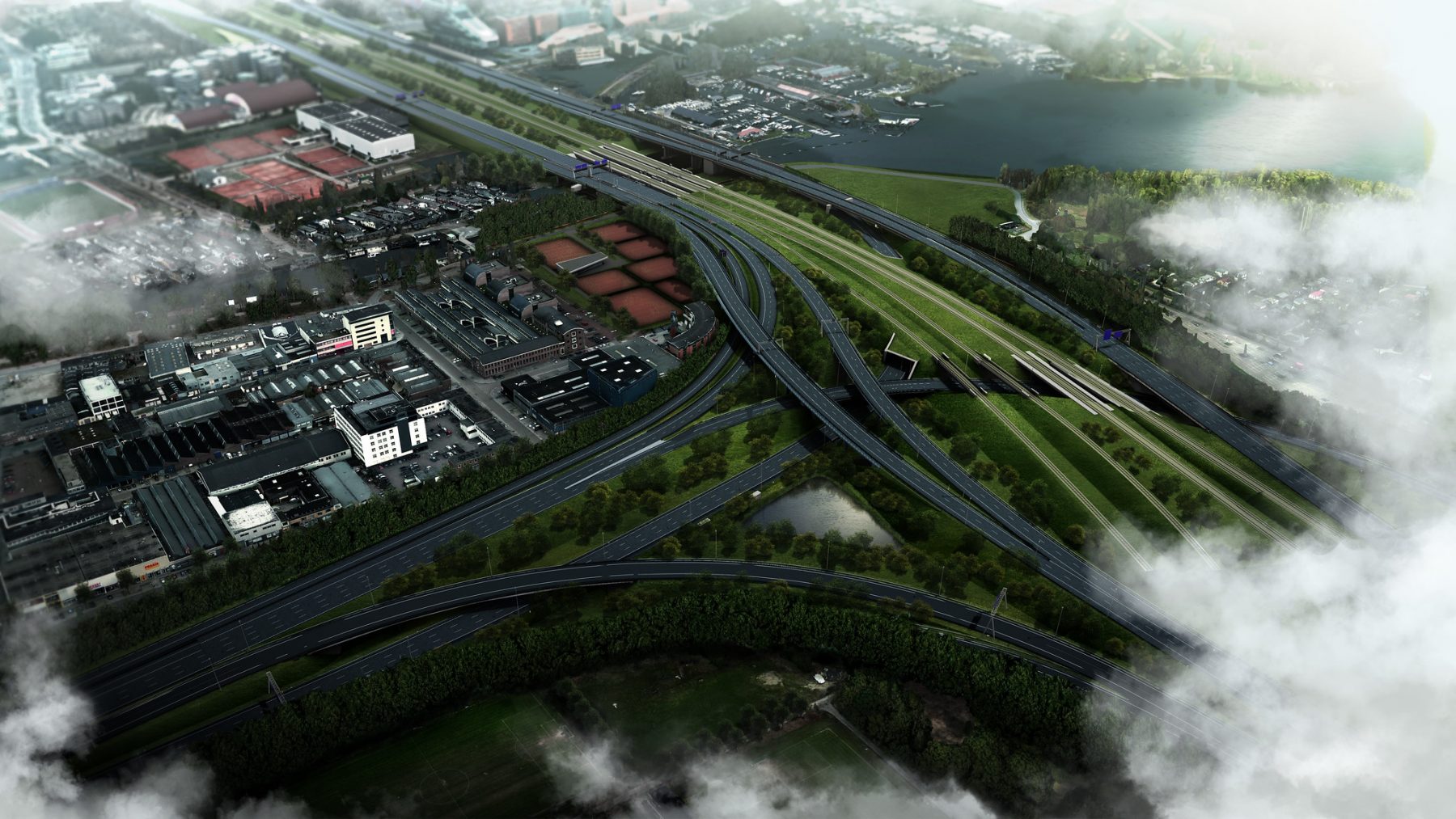Omgevingsmanager Kasper Moree van TriAX, de combinatie van Dura Vermeer, Heijmans en Besix, gaat al een tijdje mee. Maar op geen enkel moment wekt hij de indruk dat zijn werk routineus is geworden. ‘Overal kom je weer andere belanghebbenden tegen. De situatie is altijd uniek en de oplossingen die je samen vindt zijn dat ook.’
Wederzijds begrip
Dat geldt ook voor de kersverse bouwcombinatie zelf. ‘De drie partijen die TriAX vormen brengen heel veel ervaring mee, maar hebben natuurlijk alle drie hun eigen cultuur. Toch zie ik geleidelijk een TriAX-identiteit ontstaan. Dat is ook nodig, want zeker wanneer de uitvoering losgaat, wil je gesteld staan voor dit enorme project.’ Wat daarbij gaat helpen, is dat TriAX vanaf eind april een eigen plek krijgt, pal naast knooppunt De Nieuwe Meer, in de sporendriehoek die de metro- en spoorlijnen vormen tussen Amsterdam West en Zuid. ‘Dan zitten we bij elkaar én bovenop ons project. En niet te vergeten: tussen onze buren. Ik ben ervan overtuigd dat daardoor gemakkelijker wederzijds begrip ontstaat. Bij onze buren voor ons project. Bij het project voor onze buren.’
Als omgevingsmanager speel je daar een sleutelrol in. Hoe bouw je aan begrip en vertrouwen?
‘Natuurlijk beginnen we niet bij nul. Vanuit onze opdrachtgever Zuidasdok lopen al heel veel relaties met een breed palet aan belanghebbenden. Denk aan bedrijven, een watersportvereniging, een tennisclub, woonbootbewoners, weggebruikers et cetera. Het is belangrijk dat TriAX aansluit bij de contacten die er al zijn, zodat wij een gezicht krijgen. Dat gaan we de komende tijd doen in de vorm van roadshows: we gaan langs bij al die partijen die iets van de vernieuwing van knooppunt De Nieuwe Meer gaan merken. We gaan uiteraard vertellen over het werk dat we gaan uitvoeren, wanneer wij elkaar tegenkomen, maar we gaan ook luisteren naar wat mensen en organisaties ons te zeggen hebben. Zo bouwen we een relatie met onze buren, kunnen we specifieke informatie geven en weten we beter waarmee we extra rekening moeten houden.’
Wat gaan die belanghebbenden op korte termijn merken?
‘Vooralsnog weinig. Het meeste werk doen we nu nog binnen. Sinds de gunning van het project werken we toe naar een definitief ontwerp. Daarvoor moeten we het knooppunt, maar bijvoorbeeld ook de Schinkelbrug, heel precies in kaart brengen: hoe hoog ligt de weg exact, hoe diep is de Schinkel ter plekke, zijn er dingen veranderd waarvan we niet wisten. Noem maar op. We doen tal van onderzoeken. Dat begint al eind maart en duurt zeker tot de zomer. Vanaf de zomer starten we ook met de trillingsmetingen rondom de gebouwen in de buurt. Die stellen ons in staat om tijdens het werk afwijkingen te kunnen monitoren. Ondanks dat dit soort werkzaamheden nauwelijks opvalt, melden we het wel aan de omgeving. We willen namelijk altijd laten weten dat we er zijn, wat we doen en waarom.’
Wanneer komt de eerste hinder?
‘Dat duurt dus nog wel even. De uitvoering start naar verwachting in de zomer van 2024, maar het is niet zo dat er dan meteen beton gestort wordt of zoiets. Het werk zal beginnen met logistieke zaken, zoals de aanleg van bouwterreinen en van de wegen daar naartoe. ‘Er is al een planning op hoofdlijnen die gaandeweg steeds gedetailleerder wordt.’

Wat voor omgeving verwacht je?
‘Een kritische en een goed geïnformeerde omgeving, want belanghebbenden zijn er al lang mee bezig. En er is natuurlijk sprake van een zeer diverse omgeving. Woonbootbewoners zijn van een andere orde dan een bedrijf of een vereniging. We zullen af en toe zo dicht bij een bedrijfspand moeten bouwen, dat de werknemers overlast zullen ervaren. Maar als je in de buurt woont, ligt dat natuurlijk anders. Daar ga je immers juist ná werktijd naartoe en zoek je de huiselijkheid, op een uniek plekje van Amsterdam. Dat is een kwetsbare positie dus daar moeten we extra alert op zijn. Ik geloof niet in een ‘lastige’ omgeving. Iedereen is voor rede vatbaar. Voorwaarde is dat wij eerlijk en betrouwbaar zijn. Vaststaat dat de werkzaamheden uitgevoerd moeten worden en voor overlast gaan zorgen. Maar dat betekent niet dat we geen rekening houden met onze buren. Hopelijk kunnen we soms zelfs tegemoetkomen aan specifieke belangen door bijvoorbeeld een werkwijze aan te passen. Mijn ervaring is dat het voor een uitvoerder soms om iets heel kleins gaat, terwijl het voor een stakeholder juist heel groot is. Het belangrijkste is het goede gesprek voeren, vanuit wederzijds respect. Dan leer je elkaar kennen en kan er vertrouwen ontstaan.’


Zuidasdok
De reconstructie van knooppunt De Nieuwe Meer is onderdeel van Zuidasdok. We bouwen een nieuwe fly-over en verbreden de A10 Zuid van vier naar zes rijstroken per rijrichting. We werken aan een veilige en betere doorstroming van de A10 Zuid. Om dit mogelijk te maken zijn ingrijpende wijzigingen nodig aan knooppunt De Nieuwe Meer – en later ook aan knooppunt Amstel. We vernieuwen station Amsterdam Zuid en in het hart van de Zuidas gaat de A10 ondergronds om ruimte te maken voor de uitbreiding van station Amsterdam Zuid.

Give your opinion